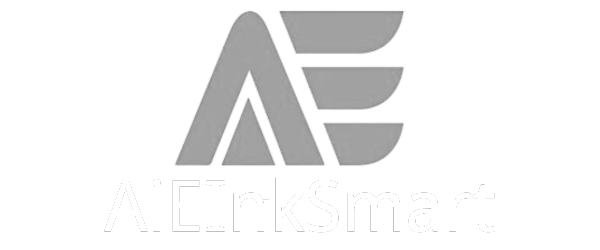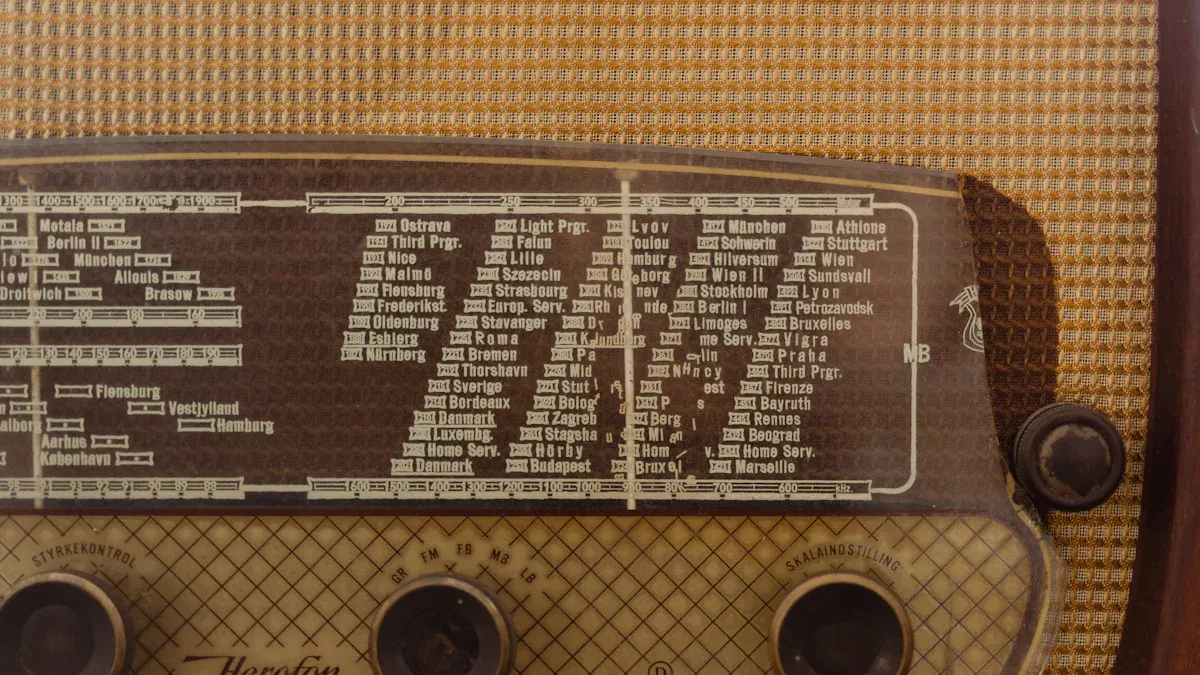
Electronic shelf labels now drive major advances in retail. Global adoption continues to surge, with the market reaching nearly USD 1.33 billion in 2024 and North America holding over 38% share. 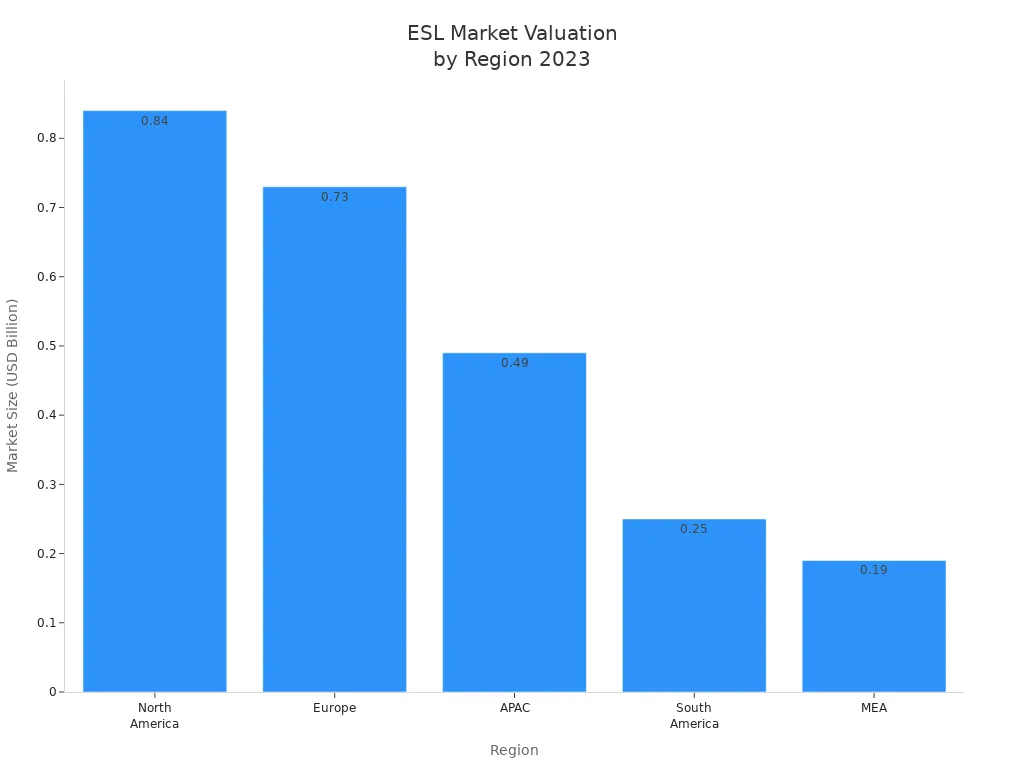

| Metric/Aspect | Data/Insight |
|---|---|
| Global Market Size (2024) | Nearly USD 1.33 Billion |
| North America Market Share | Largest revenue share over 38% in 2024 |
| Key Market Drivers | Retail sector expansion, automation, sustainability, IoT integration |
Retailers select advanced frequency and communication technologies to maximize efficiency, security, and customer experience. Esl Retail solutions like ESL Gateway AP and ESL Price Tag support operational efficiency and cost reduction by enabling real-time updates and seamless integration.
Current Wireless Electronic Shelf Labels Technology
Common Wireless Protocols in Electronic Shelf Labels
2.4 GHz and Sub-GHz Radio Frequency Bands
Retailers rely on both 2.4 GHz and sub-GHz radio frequency bands for wireless electronic shelf labels. The 2.4 GHz band supports high data rates and broad compatibility, making it a popular choice for many wireless systems. Sub-GHz frequencies, such as those used by M2COMM’s Si4463 and FG23 SoC, offer better signal penetration through shelves and store obstacles. This advantage reduces interference and improves communication reliability in dense retail environments. Sub-GHz technology also extends the range of wireless electronic shelf labels, which helps large stores maintain consistent data synchronization without excessive infrastructure costs.
Bluetooth Low Energy and Zigbee
Bluetooth Low Energy (BLE) and Zigbee have become leading protocols in the electronic shelf labels market. BLE gained momentum after the Bluetooth Special Interest Group introduced a new wireless standard for electronic shelf labels in 2023. This standard delivers scalable, ultra-low power, and secure communication, addressing previous vendor lock-in issues. Zigbee stands out for its efficient wireless communication, low power consumption, and scalability. It remains especially suitable for large retail environments, with the Zigbee segment projected to reach US$ 615.7 million in 2024 and grow at an 18.4% CAGR through 2034. Both BLE and Zigbee enable real-time updates and seamless integration with store management systems.
Tip:
Zigbee and BLE both support bidirectional communication, which allows electronic shelf labels to receive updates and send status information back to the central system.
Infrared and NFC Communication
Infrared (IR) and Near Field Communication (NFC) play smaller roles in wireless electronic shelf labels. IR supports one-to-one communication but lacks security and scalability, limiting its use in modern retail. NFC, while secure and suitable for short-range applications, remains costly compared to Bluetooth and RFID. As a result, NFC holds a smaller market share in the electronic shelf labels segment.
| Wireless Protocol | Market Position | Key Features | Market Share / Segment Size | Growth Rate (CAGR) |
|---|---|---|---|---|
| Radio Frequency (including ZigBee, Z-Wave, BLE) | Highest contributor | Bidirectional communication, integration with ZigBee, Z-Wave, BLE | Leading segment in ESL market | 12.7% |
| ZigBee | Significant and growing | Efficient wireless communication, low power, scalable, secure | US$ 615.7M (2024) | 18.4% |
| BLE | Emerging strongly | Ultra-low power, highly secure | Growing adoption | N/A |
| Wi-Fi | Growing robustly | Expanding retail adoption | 200M units (2023) | ~15% |
| NFC | Second largest | Short range, costly | Smaller share | N/A |
| IR | Smaller share | One-to-one, less secure | Limited use | N/A |
Wired and Hybrid Communication Technology
Power Line Communication in ESLs
Some electronic shelf labels use power line communication, transmitting data over existing electrical wiring. This approach reduces the need for additional wireless infrastructure and can simplify installation in certain store layouts. Power line communication offers stable connectivity but may lack the flexibility of wireless solutions.
Hybrid Wired-Wireless Electronic Shelf Labels
Hybrid systems combine wired and wireless communication. These systems use wired connections for power and core data transfer, while wireless links handle updates and remote management. Hybrid technology provides reliability and flexibility, supporting stores with complex layouts or high interference.
Limitations of Existing Wireless Electronic Shelf Labels Technology
Range, Interference, and Scalability
Wireless electronic shelf labels face several challenges:
- Wireless range limitations and interference can disrupt connectivity, especially in large stores.
- Retailers often invest up to $15,000 per store in extra access points to maintain reliable connections.
- Connectivity issues may cause data lags, delaying price updates by up to 30 minutes.
- Interference from other wireless devices and complex layouts worsens these problems.
- Managing up to 50,000 electronic shelf labels in stores over 20,000 sq ft requires advanced network management.
- Mesh networks can cost over $10,000 per store.
- Poor update performance can reduce customer satisfaction by 10%, impacting sales.
M2COMM’s sub-GHz wireless technology addresses some of these issues by improving signal penetration and reducing interference, which enhances scalability and reliability.
Maintenance and Integration Challenges
Maintenance and integration present ongoing challenges for wireless electronic shelf labels:
- Technical knowledge, training, and complex setup increase long-term costs.
- Network or system failures disrupt label accuracy and store operations.
- Integration with inventory and POS systems adds complexity and requires compatibility checks.
- Maintenance costs include battery replacement and system updates.
- Despite these challenges, wireless electronic shelf labels reduce labor costs and errors from manual updates, supporting dynamic pricing and real-time promotions.
Note:
Ensuring compatibility with store management systems and planning for battery replacement are critical for maximizing the return on investment in electronic shelf labels.
Frequency Bands and Global Standards for Electronic Shelf Labels
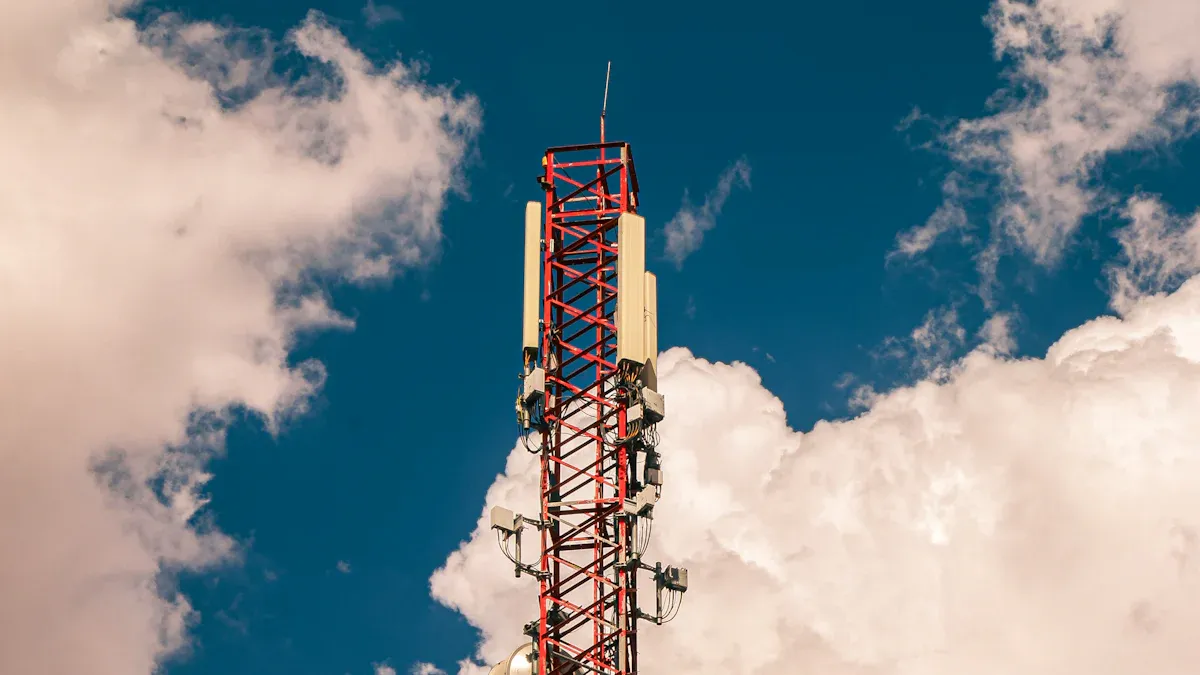
Regional Frequency Regulations and Compliance
US, EU, and Asia Frequency Standards
Retailers deploying wireless electronic shelf labels must navigate a complex landscape of regional standards. In the United States, the Federal Communications Commission (FCC) regulates all devices emitting radio frequencies, including those using Bluetooth or Wi-Fi. Each device must obtain FCC ID registration and demonstrate compliance with electromagnetic compatibility and safety directives. The European Union enforces CE marking under directives such as the Low Voltage Directive and EMC Directive. Manufacturers must provide detailed product declarations, including manufacturer information and applicable European standards. The CE marking process also requires correct labeling and traceability, with non-compliance potentially resulting in fines or product recalls. Asian markets generally align with international standards, but some countries, like Thailand, introduce local adaptations such as updated labeling requirements. Retailers must stay informed about these evolving regulations to ensure smooth market entry and ongoing operational compliance.
Regulatory Considerations for Wireless Electronic Shelf Labels
Wireless electronic shelf labels must also address data privacy and environmental regulations. In Europe, the General Data Protection Regulation (GDPR) sets strict requirements for consumer data protection. North America enforces similar standards through the California Consumer Privacy Act (CCPA). These laws require robust data security measures within the communication technology and system architecture. Environmental regulations further influence product design, encouraging the use of energy-efficient and eco-friendly materials. Software, especially firmware, plays a critical role in maintaining compliance. Manufacturers must control software updates and use digital signatures to ensure devices operate within safe parameters throughout their lifecycle. Adhering to these requirements supports both legal compliance and consumer trust.
Criteria for Frequency Selection in ESL Technology
Signal Penetration and Store Layout Impact
Selecting the right frequency band for wireless electronic shelf labels depends on several factors. Signal penetration remains a top priority, especially in stores with dense shelving or complex layouts. Sub-GHz frequencies often provide better penetration through obstacles, supporting reliable communication across large retail spaces. The choice of frequency also affects the number of access points required, which impacts both installation costs and system scalability. Retailers must evaluate their store layout and infrastructure to determine the optimal technology for their environment.
Interference Management and Device Compatibility
Effective interference management ensures stable wireless communication in busy retail settings. Many stores operate multiple wireless systems, including Wi-Fi, Bluetooth, and security networks. Overlapping frequencies can cause congestion and disrupt label updates. Advanced frequency management strategies, such as channel hopping and adaptive protocols, help minimize interference. System compatibility also plays a vital role. Retailers should prioritize solutions that integrate seamlessly with existing infrastructure and support future upgrades. Ensuring compatibility with store management systems and other devices reduces operational risks and maximizes return on investment.
Emerging Communication Technology Trends in Wireless Electronic Shelf Labels for 2025
Next-Generation Wireless Protocols and Frequency Innovations
Wi-Fi 6, Wi-Fi 7, and 5G Integration
Retailers now explore Wi-Fi 6, Wi-Fi 7, and 5G as core components of their wireless communication technology strategies. Wi-Fi 6 offers higher data rates, improved capacity, and better performance in crowded environments. This advancement supports thousands of electronic shelf labels operating simultaneously without signal congestion. Wi-Fi 7, expected to roll out in more retail environments by 2025, brings even lower latency and multi-link operation, which further enhances real-time price updates and inventory management.
5G integration introduces ultra-reliable low-latency communication, making it possible to connect electronic shelf labels across large retail spaces or even multiple store locations. Retailers benefit from seamless two-way communication between central management systems and shelf labels, ensuring instant updates and synchronized promotions. These next-generation protocols also support advanced features such as dynamic pricing and interactive displays, which improve the customer experience.
Ultra-Wideband (UWB) and LoRa Technology
Ultra-Wideband (UWB) and LoRa technology represent significant innovations in wireless protocols for electronic shelf labels. UWB enables precise location tracking and secure short-range communication. Retailers use UWB to monitor product movement and shopper interactions in real time, which helps optimize store layouts and personalize marketing efforts.
LoRa technology excels in long-range, low-power wireless communication. Large retail chains deploy LoRa-enabled electronic shelf labels to maintain reliable connectivity across vast store areas with minimal infrastructure. LoRa’s energy efficiency extends device lifespans and reduces maintenance costs. These innovations allow retailers to scale their electronic shelf label deployments while maintaining robust communication and operational efficiency.
Note:
VusionGroup’s EdgeSense technology leverages Bluetooth Low Energy (BLE) for real-time 3D geolocation, product tracking, and personalized shopper engagement. BLE’s ultra-low power consumption and compatibility with smartphones enable new levels of interactivity and efficiency in electronic shelf label systems.
IoT and Edge Computing in Electronic Shelf Labels
Real-Time Data Synchronization and Decentralized Control
The integration of IoT and edge computing transforms how retailers manage electronic shelf labels. IoT connectivity links shelf labels with inventory systems, point-of-sale terminals, and cloud-based analytics platforms. Edge computing processes data locally, reducing latency and ensuring that price changes and inventory updates occur in real time.
Decentralized control allows each electronic shelf label to operate independently while remaining synchronized with the central system. This approach improves system resilience and reduces the risk of network-wide failures. Retailers gain the ability to automate restocking alerts, monitor shelf conditions, and trigger dynamic promotions based on real-time data. Cloud-based management platforms, enhanced by AI, further optimize pricing and inventory decisions, relying on advanced wireless protocols for seamless communication.
- Bluetooth Low Energy (BLE) improves data update speed and system reliability.
- Ultra-low power modules extend deployment cycles and reduce maintenance.
- Cloud-based platforms enable predictive pricing and inventory optimization.
AI-Driven Optimization in ESL Communication Technology
Adaptive Frequency Management
AI-driven optimization plays a critical role in managing wireless communication for electronic shelf labels. Machine learning algorithms analyze network conditions and automatically adjust frequency channels to minimize interference. This adaptive frequency management ensures reliable data transmission, even in dense retail environments with multiple wireless systems.
AI-enabled wireless communication protocols optimize network performance, reducing latency and supporting real-time updates. Retailers benefit from improved operational efficiency and reduced downtime. AI also enables automatic price adjustments based on demand, competitor activity, and historical sales data, maximizing profitability and reducing stockouts.
| Advancement Area | Description |
|---|---|
| AI-Driven Pricing Optimization | AI algorithms analyze sales data, competitor pricing, and consumer demand to dynamically adjust prices in real time, optimizing profits and reducing stockouts. |
| AI-Enabled Wireless Communication Protocols | AI optimizes network protocols for seamless, low-latency data transmission between ESLs and control systems, ensuring reliable updates even in dense retail environments. |
| Predictive Maintenance and Lifecycle Management | AI analyzes sensor data to predict failures, optimize maintenance schedules, and extend ESL device longevity, minimizing downtime and improving sustainability. |
| Customized Solvent Formulations and Sustainable Manufacturing | AI integration enhances solvent chemistry used in ESL components, improving durability, energy efficiency, and environmental compliance. |
Predictive Maintenance and Self-Healing Networks
Predictive maintenance and self-healing networks represent major advancements in electronic shelf label deployments. AI-powered systems monitor device health and predict failures before they disrupt operations. These systems use sensor data and machine learning models to detect anomalies, schedule maintenance, and automate corrective actions.
Self-healing cables and insulation autonomously repair damage, maintaining signal quality and reducing the risk of outages. Integration with IoT and sensors enables real-time monitoring, further minimizing downtime. This technology extends the lifespan of electronic shelf labels and reduces maintenance costs, supporting sustainable and reliable retail operations.
- Predictive maintenance models detect equipment anomalies and predict failures before they occur.
- Human-in-the-loop feedback refines model accuracy over time.
- Integration with enterprise systems automates maintenance workflows and triggers service notifications.
- Inventory optimization ensures spare parts are available only when needed, reducing costs.
- Overall equipment effectiveness improves by preventing unplanned downtime and maintaining performance.
Tip:
Successful predictive maintenance requires a culture of early anomaly reporting, continuous training, and shared responsibility. This approach ensures high availability and reliability for wireless electronic shelf labels.
Impact of Wireless Electronic Shelf Labels Technology on Retail Operations
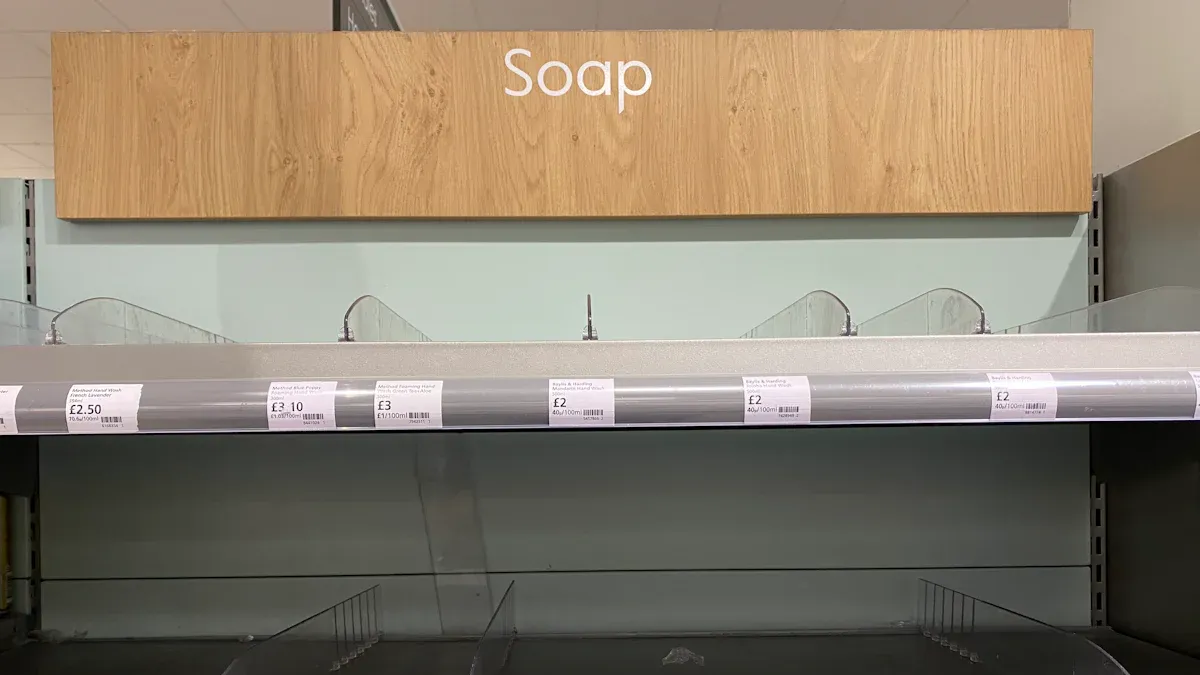
Efficiency and Automation in Store Management
Real-Time Price Updates and Inventory Integration
Wireless electronic shelf labels transform retail operations by automating pricing and inventory processes. These systems connect directly to central management platforms, integrating with POS and inventory software. Retailers benefit from real-time updates, which ensure that shelf pricing always matches the checkout system. This alignment eliminates manual price changes and reduces errors.
- Electronic shelf labels automate price updates across all shelves, saving significant labor hours.
- Centralized control enables bulk pricing adjustments and scheduled promotions, improving efficiency.
- Two-way communication allows each label to report battery status and malfunctions, supporting proactive maintenance.
- Remote monitoring and management reduce the need for physical checks, increasing operational efficiency.
- AI-driven pricing optimization and smart inventory tracking further automate restocking and personalized promotions.
Retailers using these systems experience fewer pricing discrepancies and improved customer trust. The reliability and durability of electronic shelf labels support consistent operations, even in large stores. Shoppers see accurate, up-to-date information, which enhances the overall retail experience.
Security Enhancements in ESL Communication
Encrypted Protocols and Access Control
Modern electronic shelf labels prioritize data security and system integrity. Retailers implement encrypted protocols to protect pricing updates from cyber threats. These systems use advanced encryption, such as AES-128, to secure data transmission and storage. Each device receives a unique encryption key, preventing unauthorized access and tampering.
- Bluetooth-based systems employ custom encryption for secure wireless communication.
- NFC interactions use bidirectional authentication, ensuring only authorized users can update pricing.
- Physical security features, such as tamper-proof designs, deter unauthorized disassembly.
- Real-time tracking detects abnormal activity, supporting theft prevention and system reliability.
Access control mechanisms restrict who can make changes to pricing or system settings. Audit trails and user permissions provide transparency and accountability. These measures ensure that only authorized personnel can modify sensitive data, protecting retailer profits and customer trust.
Cost-Effectiveness and Energy Efficiency
Lower Maintenance and Operational Costs
Electronic shelf labels offer significant cost-effectiveness compared to traditional paper labeling. While the initial investment is higher, retailers save on recurring material and labor costs. Automated updates eliminate manual label changes, reducing errors and freeing staff for higher-value tasks.
| Aspect | Traditional Paper Labeling | Electronic Shelf Labels (ESL) |
|---|---|---|
| Initial Investment | Low upfront cost | Higher upfront cost |
| Recurring Material Cost | High (paper, ink, adhesives) | None |
| Labor Costs | High (manual updates) | Low (automated updates) |
| Error Rate | Higher | Lower |
| Energy Consumption | Higher | Lower (e-ink technology) |
| Maintenance | Frequent replacement | Minimal, durable for years |
| Total Cost of Ownership | Higher over time | Lower over time |
| ROI | N/A | Typically under 2 years |
Energy-efficient e-ink displays reduce power consumption, supporting sustainability goals. The durability of these systems means less frequent maintenance and replacement. Retailers achieve long-term savings and improved efficiency, making electronic shelf labels a smart investment for modern retail environments.
Customer Experience Improvements with Electronic Shelf Labels
Dynamic Pricing, Promotions, and Interactive Displays
Electronic shelf labels transform the retail environment by delivering a seamless and engaging shopping experience. These systems provide real-time pricing updates, ensuring that shelf prices always match the checkout system. Customers see accurate information, which builds trust and reduces confusion at the point of sale. Retailers use dynamic pricing to adjust prices instantly based on demand, competitor activity, or promotional strategies. This flexibility allows stores to respond quickly to market changes and offer competitive deals.
Shoppers benefit from interactive displays that extend beyond basic pricing. Electronic shelf labels act as digital signage, presenting not only prices but also sales, stock levels, and important alerts. This approach reduces visual clutter and maintains a clean, professional store appearance. Customers can access comprehensive product information, such as nutritional data, sourcing details, and customer reviews, directly at the shelf. This transparency helps shoppers make informed decisions quickly and confidently.
- Electronic shelf labels display QR codes that link to online reviews, detailed product descriptions, or instructional videos. Shoppers scan these codes with their smartphones to access additional information, creating an e-commerce-like experience in-store.
- Retailers highlight key promotions and loyalty rewards directly on the labels. These visible offers encourage impulse purchases and increase basket size.
- Instant updates to pricing and product details eliminate mismatches, which increases customer satisfaction and speeds up the checkout process.
- Integration with NFC technology allows customers to interact with labels using their mobile devices, enabling quick access to extended product information or even mobile checkout.
Digital pricing technology supports personalized and contextual promotions. Retailers use customer loyalty data to tailor offers, making them more relevant and timely. For example, a shopper might see a special discount on a favorite product or a flash sale that matches their preferences. Automated inventory and pricing updates ensure that promotions remain current and accurate, enhancing the overall shopping environment.
Digital wayfinding and product highlighting features help customers locate items that match specific needs, such as gluten-free or organic products. This guidance reduces shopping time and improves satisfaction. By integrating electronic shelf labels with POS systems, retailers streamline the entire shopping journey, from product discovery to checkout.
Tip:
Retailers who leverage real-time pricing updates and interactive displays create a more engaging and efficient shopping experience, setting themselves apart in a competitive market.
Addressing Challenges in Electronic Shelf Labels Frequency and Communication
Interference, Congestion, and Channel Management
Wireless electronic shelf labels operate in environments filled with potential sources of interference. Retailers encounter challenges from devices such as microwaves, cordless phones, overlapping Wi-Fi networks, and other Bluetooth devices. These sources can disrupt communication and reduce system reliability.
To address these issues, retailers implement several strategies:
- Bluetooth Low Energy (BLE) uses adaptive frequency hopping to avoid congested channels.
- ZigBee employs spread spectrum and frequency agility techniques, which help maintain stable wireless communication.
- Network planners select non-overlapping Wi-Fi channels, such as channels 1, 6, and 11 in the 2.4 GHz band, to minimize congestion.
- Access points are placed centrally and away from physical obstacles to optimize coverage and reduce interference.
- Site surveys identify interference sources and inform network layout decisions.
- Shielding and proper grounding further reduce electromagnetic interference.
- Network management tools monitor device status, support remote troubleshooting, and enable regular firmware updates.
- Retailers conduct periodic interference assessments to maintain optimal system performance.
Tip:
Regular site surveys and firmware updates help retailers adapt to changing store environments and maintain high reliability for wireless electronic shelf labels.
Solutions for Store Environment Adaptation
Retailers adapt their wireless communication systems to unique store layouts and operational needs. They use network management tools to monitor performance and quickly resolve issues. Centralized access points and careful placement ensure consistent coverage, even in stores with complex shelving or high device density. Shielding and grounding techniques further enhance reliability and durability, supporting uninterrupted operation.
Security Risks and Data Protection in Wireless Electronic Shelf Labels
Wireless electronic shelf labels introduce new data security and privacy challenges. Retailers must address risks related to unauthorized access, consumer data collection, and system reliability.
Common risks include:
- Collection of biometric or profiling data without proper consent, raising privacy concerns.
- Dynamic pricing features that may lead to price discrimination or regulatory violations.
- Technical errors in updates, which can cause inconsistent pricing and mislead consumers.
- Algorithmic pricing and market consolidation, which may attract antitrust scrutiny.
- Brand reputation risks from perceived invasive data collection or unfair pricing.
To mitigate these risks, retailers implement robust security measures:
- Password protection, permanent locks, and access controls prevent unauthorized scanning of RFID tags.
- Passive UHF RFID tags only respond when near a reader, reducing tracking concerns.
- Data stored on tags remains limited to product codes, while sensitive information stays in secure backend systems.
- Tags can be deactivated at checkout to protect post-purchase privacy.
- Backend systems use encryption, secure APIs, and access controls to safeguard data.
- Compliance with regulations such as GDPR and CCPA ensures legal and reputational protection.
Alert:
Transparency, consumer consent, and strong data security protocols are essential for maintaining trust and meeting regulatory requirements in wireless electronic shelf label deployments.
Compliance with Privacy Regulations
Retailers use electronic shelf labels to support compliance with regional privacy and consumer protection laws. These systems ensure price accuracy and transparency, which helps meet legal standards. Centralized control and audit trails allow retailers to demonstrate compliance with pricing regulations. Real-time updates enable quick price adjustments and compliant promotions.
Key compliance practices include:
- Managing personalized pricing while respecting data privacy regulations.
- Implementing robust cybersecurity measures and encryption protocols.
- Safeguarding transactional records against unauthorized access.
- Addressing integration challenges with existing IT infrastructure.
- Adapting to evolving regional standards, such as GDPR in the EU and FDA labeling in the U.S.
Governments worldwide encourage secure, sustainable, and energy-efficient display technologies. Vendors respond by offering solutions tailored to regional legal frameworks, ensuring that retailers can maintain compliance and protect consumer data.
Scalability and Future-Proofing ESL Technology
Retailers require electronic shelf label systems that scale with business growth and adapt to future needs. Scalability and future-proofing ensure that investments remain valuable as technology and operational requirements evolve.
Strategies for scalability and upgradability include:
- Employing trained installation teams to ensure consistent deployment across locations.
- Implementing national coverage for scalable rollouts.
- Using internal auditing and verification to maintain installation quality.
- Selecting solutions that integrate easily with existing POS and inventory systems.
- Choosing flexible display options, such as e-paper and LCD, to suit diverse shelf types.
- Prioritizing long battery life to reduce maintenance and support durability.
- Adopting modular and slim designs for compatibility with various store layouts.
- Leveraging advanced connectivity for real-time updates and analytics.
Retailers also benefit from solutions that support versatile applications, including asset tracking and work order management. Integration with AI-driven analytics and IoT enables dynamic pricing, automated restocking, and centralized control across multiple locations. These features enhance operational efficiency and support omnichannel retail strategies.
Note:
The rapid digitalization of retail operations increases the need for electronic shelf labels that offer dynamic updates, centralized control, and immediate data synchronization. Modular design and upgradability ensure long-term reliability and durability, making these systems a smart investment for retailers focused on growth and innovation.
Key Considerations for Retailers Upgrading Electronic Shelf Labels in 2025
Evaluating Communication Needs and Store Requirements
Store Size, Layout, and System Integration
Retailers planning to upgrade digital labeling solutions in 2025 must evaluate several factors to ensure successful deployment. Store size and layout influence the choice of communication technologies, such as infrared, NFC, or radiofrequency, to guarantee seamless integration and real-time updates. Larger stores often require robust wireless modules to maintain consistent updates across all shelves. Integration with ERP and POS systems remains essential for dynamic pricing and omnichannel consistency. Retailers also need to consider display types, such as e-paper or LCD, and select sizes that enhance customer engagement.
Power management plays a critical role in extending device lifecycle and reducing maintenance. Sustainability goals drive the adoption of recycled materials and rechargeable batteries. Legal and regulatory risks have increased as dynamic pricing capabilities expand. Regulators now scrutinize pricing practices, warning against discriminatory or exploitative pricing. Technical glitches can cause incorrect price displays, sometimes forcing store closures. Retailers must assess these risks before deployment to avoid consumer protection issues.
| Key Factor Category | Details and Considerations |
|---|---|
| Communication Technologies | Infrared, NFC, Radiofrequency to ensure seamless integration and real-time updates |
| System Compatibility | Integration with ERP and POS systems for dynamic pricing and omnichannel consistency |
| Display Types and Sizes | E-paper ESL, LCD ESL; sizes chosen based on store layout and customer engagement goals |
| Power Management | Wireless module capabilities to extend device lifecycle and reduce maintenance |
| Sustainability | Use of recycled materials, rechargeable batteries to meet environmental goals |
| Legal and Regulatory Risks | Compliance with laws on dynamic pricing and consumer protection |
| Supply Chain and Tariffs | Impact of tariffs on procurement flexibility and cost; need for risk mitigation strategies |
| Operational Benefits | ESLs used for operational efficiency, inventory control, and customer behavior analytics |
| Risk Assessment | Consideration of technical glitches and potential misuse of dynamic pricing |
Retailers should leverage central management software to coordinate bulk price adjustments, display nutritional information, and streamline inventory and restocking efficiency.
Vendor Selection and Ecosystem Compatibility in ESL Technology
Open Standards vs. Proprietary Solutions
Vendor selection shapes the long-term success of electronic shelf label deployments. Retailers must assess business needs, including store size, product range, and desired features such as price updates and inventory tracking. Compatibility with existing POS and inventory management software ensures smooth operation. Wireless protocol compatibility, including WiFi, BLE, and NFC, affects reliability and suitability for different retail environments.
Scalability and integration capabilities, such as cloud-based management and analytics platforms, enable future growth. Strong vendor support for onboarding, training, technical assistance, software updates, and remote diagnostics maintains system reliability. Transparent pricing and total cost of ownership, including hardware, software, installation, and ongoing support, influence sustainability.
Retailers face barriers like high initial deployment costs and compatibility issues with legacy POS systems. Cybersecurity concerns and lack of standardization complicate large-scale integrations. Leading vendors invest in R&D and innovation, supporting scalability and future-proofing. Strategic vendor selection aligned with ecosystem compatibility helps retailers overcome challenges and ensures sustainable deployment. High-quality mounting solutions and accessories also impact operational uptime and environmental goals.
Tip:
Retailers who choose vendors offering robust, interoperable solutions and reliable support achieve better long-term outcomes and avoid costly disruptions.
Planning for Future Upgrades and ROI
Technology Roadmaps and Budgeting
Retailers maximize return on investment by following best practices for planning upgrades. They start with careful financial planning, weighing upfront costs against long-term savings. Choosing scalable and upgradable platforms allows for easy expansion as business needs evolve. Phased rollout strategies, including pilot programs, minimize operational disruption and identify integration challenges early.
Integration with existing POS and inventory management platforms streamlines operations and enables instant pricing updates. Ongoing staff training and clear communication ensure smooth transitions and maximize system utilization. Vendor support for maintenance, software updates, and troubleshooting maintains system reliability. Retailers often start small and gradually scale deployments to manage budget constraints and operational impacts.
Retailers report up to a 95% reduction in price update time and near elimination of pricing errors by following best practices such as pilot testing, vendor selection, and comprehensive staff training. Major companies emphasize phased rollouts and network upgrades to overcome integration challenges and maximize ESL benefits.
Retailers monitor key performance indicators, such as labor cost reductions, pricing accuracy improvements, and customer satisfaction, to maximize benefits and ROI. Payback periods for ESL investments typically range from two to three years, with some cases achieving break-even in one year when combined with AI-based price optimization. Effective planning aligns investments with budget cycles and forecasts, supporting sustainable growth in retail operations.
The Future of Wireless Electronic Shelf Labels Technology
Predictions for the Next Five Years in ESL Communication
Convergence with Smart Retail and IoT
The next five years will bring rapid transformation to electronic shelf label technology. Retailers will see a strong convergence between ESL systems, smart retail platforms, and the Internet of Things (IoT). This integration will enable real-time updates, dynamic pricing, and advanced inventory management. Wireless communication protocols such as Bluetooth, Wi-Fi, and NFC will become standard, supporting seamless infrastructure across stores.
Key industry players like SoluM, Hanshow, and Pricer continue to drive innovation. They focus on energy efficiency, improved display brightness, and enhanced color capabilities. Integration with IoT and cloud analytics will allow retailers to analyze sales trends and optimize operations. NFC-based ESLs are projected to grow at a 12.8% CAGR through 2033, fueled by interactive features and operational efficiency. These labels will support personalized promotions and omnichannel retail experiences, especially as smartphone integration becomes more common.
Retailers in North America and Europe lead the market, but Asia-Pacific is expected to grow quickly due to retail modernization. Despite high initial investment and technical complexity, long-term benefits such as labor savings and pricing agility outweigh the challenges. Data privacy and security regulations will shape future ESL development, ensuring that retailers protect consumer information.
Note:
The digitalization of retail, demand for real-time pricing, and integration with RFID and cloud platforms will remain the main drivers of ESL adoption.
| Aspect | Details |
|---|---|
| Innovation | Energy efficiency, color displays, IoT and cloud analytics integration |
| Market Growth Drivers | Digitalization, real-time pricing, RFID and cloud platform integration |
| Emerging Trends | IoT and AI integration, advanced display tech, improved UI, sustainability focus |
| Challenges | High initial costs, technical complexity, power consumption, data security |
| Significant Developments | Cloud analytics, large retailer partnerships, ESLs with sensors, improved electrophoretic displays |
Preparing for Ongoing Innovation in Electronic Shelf Labels
Staff Training and Continuous Evaluation
Retailers must prepare for ongoing innovation by investing in staff training and continuous evaluation. Employee education ensures smooth adaptation to new ESL features and reduces resistance to change. Regular training sessions help staff understand system updates, troubleshoot issues, and use new functionalities effectively.
Continuous evaluation of ESL systems allows retailers to identify integration challenges, especially with older POS systems. Routine system checks prevent wireless connectivity issues that could cause pricing errors. Retailers can manage financial strain by using leasing options or phased rollouts, testing new technology before full-scale deployment.
A focus on smart pricing solutions and automated updates will improve operational efficiency. ESLs enable quick price changes, flash sales, and accurate promotions, reducing manual labor and building customer trust. Retailers who prioritize ongoing training and system evaluation will maintain competitiveness as digital transformation accelerates.
Tip:
Clear communication and regular feedback sessions help staff stay engaged and confident when using new ESL technologies.
Retailers see major advances in electronic shelf labels as wireless protocols and frequency innovations drive real-time pricing updates. Next-generation technology improves pricing accuracy, security, and operational efficiency. Automated pricing adjustments and encrypted communication protect store data. Adaptable systems support future upgrades and ensure long-term reliability. Retailers who plan proactively and evaluate store needs achieve better pricing control and customer satisfaction.
Smart investment in electronic shelf labels enables dynamic pricing, secure operations, and a superior shopping experience.
- Real-time pricing updates reduce errors.
- Automated pricing supports fast promotions.
- Secure pricing protocols protect data.
- Future-proofing ensures lasting value.
FAQ
What frequency bands do most electronic shelf labels use?
Most electronic shelf labels operate on 2.4 GHz or sub-GHz bands. These frequencies provide reliable communication and strong signal penetration in retail environments.
How do retailers ensure secure communication with ESLs?
Retailers use encrypted protocols like AES-128. They also implement access controls and audit trails to prevent unauthorized changes and protect sensitive data.
Can electronic shelf labels integrate with existing POS systems?
Yes. Most modern ESL solutions support integration with popular POS and inventory management platforms. This ensures real-time price updates and inventory synchronization.
What is the typical battery life of an electronic shelf label?
Battery life varies by display type and usage. E-ink ESLs often last 3–5 years due to low power consumption.
Are electronic shelf labels suitable for large stores?
Yes. Sub-GHz and LoRa technologies enable reliable coverage and scalability. Retailers can manage thousands of labels across large retail spaces.
What are the main benefits of using electronic shelf labels?
- Real-time price updates
- Reduced labor costs
- Fewer pricing errors
- Enhanced customer experience
Tip:
Automated ESLs help retailers respond quickly to market changes and promotions.
How do retailers handle interference in wireless ESL systems?
Retailers use adaptive frequency hopping, channel management, and site surveys. These strategies minimize interference from other wireless devices and maintain stable communication.
Do electronic shelf labels support dynamic pricing?
Yes. ESLs enable dynamic pricing by allowing instant price changes based on demand, inventory, or promotions. This flexibility helps retailers stay competitive.


